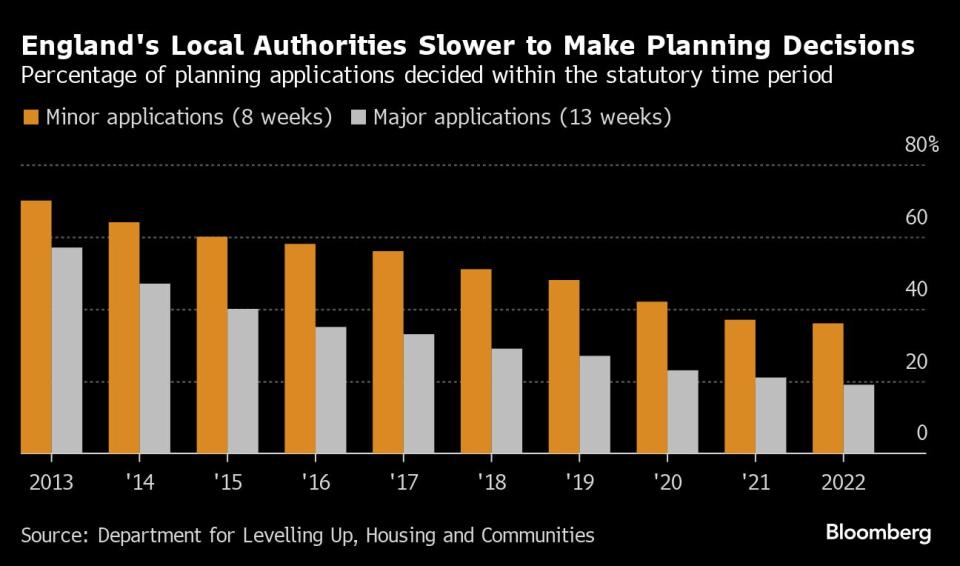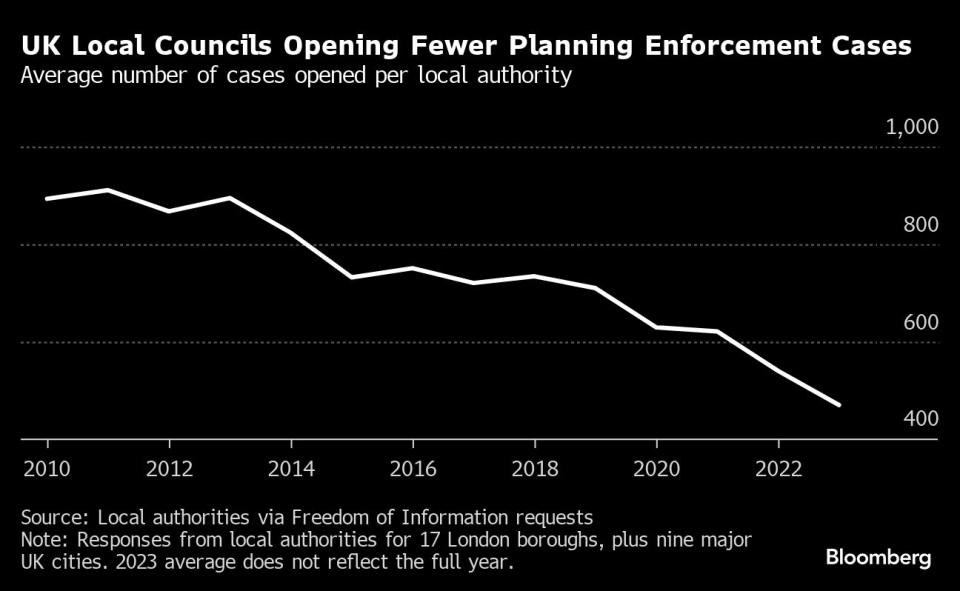UK Builders Are Going Rogue But Fewer Offenders Are Being Caught
(Bloomberg) -- Mast Quay, a 23-storey tower block overlooking the River Thames, stands as a warning to rogue builders trying to evade London’s planning system.
Most Read from Bloomberg
Citigroup Offers Partial Early Bonuses to Encourage Staff Departures
JPMorgan Is in a Fight Over Its Client’s Lost $50 Million Fortune
The £36 million ($45.5 million) apartment complex situated in London’s historic military town of Woolwich was ordered to be demolished in September after dozens of planning deviations were exposed. Amongst other failings, the developers didn’t provide a roof garden, commercial floorspace or disabled access, all promised in the planning agreement.
But not everyone gets caught. Freedom of Information requests compiled by Bloomberg show the number of cases opened in relation to alleged breaches of planning permission has been dropping for years. The average number of new cases has almost halved since 2010, causing distress and safety concerns for local residents where rogue developers are operating without punishment. That’s based on responses from local authorities for 17 boroughs of London, plus nine major UK cities.
The figures uncover another consequence of Britain’s choked planning system that’s come under increasing fire from homebuilders and is shaping up to become a key political battleground ahead of the next general election. Years of underfunding — the extent of which was revealed by Bloomberg via separate FOI requests earlier this year — have left departments depleted of staff.
“Rogue housing developments are a symptom of chronic under-resourcing,” said Andrew Shepherd, managing director at TopHat, a housebuilder that’s majority-owned by Goldman Sachs Group Inc. “To enact real, tangible change, political parties must focus on providing planning departments with the resources to bring forward nationally significant infrastructure.”
Samantha Stein, a self-employed television producer, says she endured a nightmare this year after a developer began renovating a hotel next to her home in Lincoln before securing full planning permission.
Stein asked the city’s planning department for rules to be put in place to prevent overnight construction noise, explaining it was causing her distress and that on one occasion her living room was filled with fumes. The officer said the matter could not be dealt with by the planning department, diverting her to a different council team which she said also failed to resolve the issue.
“This should never have been kicked to another department,” Stein said. “Protecting the public from upcoming development health hazards is a planning department issue, but their team has not been helpful at all.”
City of Lincoln Council declined to comment.
Stein said she thought she’d moved into her dream home two years ago, which is overlooked by Lincoln Cathedral. Since, she says construction noise from the hotel has reached 100 decibels inside her house — a level considered dangerous to human hearing — causing her to lose sleep and impact her ability to work remotely.
“I’ve had to take time off work several times,” Stein said. “I couldn’t sleep last night because I could hear them drilling, hammering and moving furniture past midnight.”
Sound complaints in England rose 54% between 2019-20 and 2020-21, with Greater London recording three times more than the national average, according to the most recent noise survey published by the Chartered Institute of Environmental Health. Formal action was taken on just 3% of the 350,000-plus noise complaints recorded by local authorities.
For some, the consequences can be fatal. Earlier this year, the Housing Ombudsman — which looks into property complaints — found severe failings in social housing provider Clarion’s handling of noise complaints by a resident, who took his own life.Read more:UK Home Buyers Thwarted by System That Can’t Build Enough HousesLabour Eyes UK’s Broken Homeownership Dream as Vote Clincher
Lack of enforcement also increases the risk of injury for builders and the local public. The number of people killed in construction-related work incidents rose to 45 in 2022-23 from 30 in 2021-22, according to the Health and Safety Executive.
“Planning enforcement suffers from less resource and enthusiasm than other parts of the planning function,” said Matthew Evans, a lawyer at Forsters LLP. “Overstretched councils will have less time to come to agreement over changes, whether or not through choice or compulsion.”
Nine in 10 local authorities have a backlog of enforcement notices, according to a survey of local authority staff conducted by the Royal Town Planning Institute. Some 80% of respondents reported that there weren’t enough officers to carry out the workload, allowing some rogue developers to go unnoticed.
The London Borough of Hounslow, which has seen its annual planning spend drop by almost half since 2010, handed out 21 enforcement notices last year compared with 150 in 2014, according to FOI requests.
Read more: UK Plan to Wind Up Leasehold Homes Includes Houses But Not Flats
And while UK housebuilding is below levels achieved in most of the last century, the amount of new homes built each year has risen since 2010. That means even as construction has accelerated, local authority action on rogue developers has dropped.
“Enforcement officers are the backbone of the planning system, protecting the public and the environment from people who commit breaches of planning control,” said Richard Blyth, head of policy practice and research at the RTPI. “Unmanageable workloads and insufficient staff have left most councils unable to meet public demand.”
The ruling Conservatives — long criticized for failing to meet promises on housebuilding — is bidding to claw back public support after Labour leader Keir Starmer zeroed in on failings in the sector and made a series of development pledges at his party’s annual conference in October.
A month later, Chancellor Jeremy Hunt unveiled plans to introduce a new permitted development right next year, enabling Britons to improve or extend their homes without the need for planning permission. It will allow for the conversion of houses into two flats without public consultation.
That move indicates the government is more concerned about the creation of new homes than tackling planning breaches, according to Forsters’ Evans.
“Central government policy could be sending signals that enforcement is less appropriate,” he said. “The expansion of permitted development rights suggests a light touch approach is the way forward, and with it an acceptance that delivery is paramount.”
At Mast Quay, the failings numbered too many for the council to ignore. In total, there were at least 26 main deviations from the original planning permission that was agreed in 2012, including visible design changes, different cladding, less glazing, smaller balconies and windows and lower-quality residential accommodation.
The council issued an enforcement notice for the building to be completely demolished and for the land to be restored to its former condition. The developer has 12 months to comply but has the right to appeal.
“Without enforcement our planning system can have no integrity,” said Ann-Marie Cousins, a Royal Borough of Greenwich councilor involved in the decision.
Most Read from Bloomberg Businessweek
SBF’s Lawyer Says His Client Was the ‘Worst’ Ever Under Cross Examination
Vanguard Is Closer Than Ever to Ending BlackRock’s ETF Reign
Rate-Cut Pivot Can’t Come Soon Enough for Debt-Strapped Companies
How the Biggest Boutique Fitness Company Turned Suburban Moms Into Bankrupt Franchisees
©2023 Bloomberg L.P.

 Yahoo News
Yahoo News 






